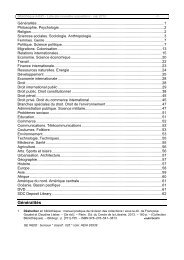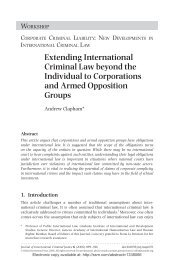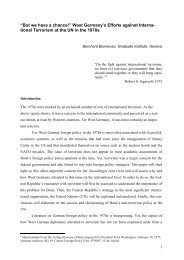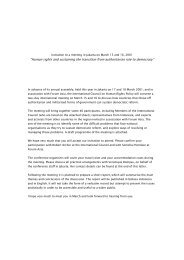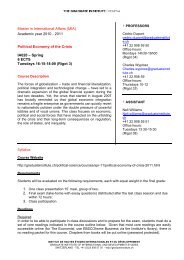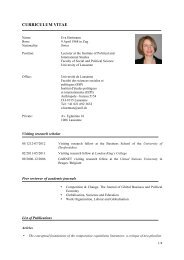The 1953 Coup D'etat in Iran Author(s): Mark J. Gasiorowski Source ...
The 1953 Coup D'etat in Iran Author(s): Mark J. Gasiorowski Source ...
The 1953 Coup D'etat in Iran Author(s): Mark J. Gasiorowski Source ...
You also want an ePaper? Increase the reach of your titles
YUMPU automatically turns print PDFs into web optimized ePapers that Google loves.
<strong>The</strong> <strong>1953</strong> <strong>Coup</strong> D'Etat <strong>in</strong> <strong>Iran</strong> 273<br />
support, would come to power through parliamentary means, and would be<br />
given "massive economic aid" by the United States or Brita<strong>in</strong>.60 A second<br />
attempt was made <strong>in</strong> late July. A U.S. Army colonel and an MI6 officer were<br />
sent to France to locate Pr<strong>in</strong>cess Ashraf, the Shah's tw<strong>in</strong> sister, who was<br />
gambl<strong>in</strong>g at the cas<strong>in</strong>os <strong>in</strong> Deauville. Ashraf agreed to speak to her brother after<br />
receiv<strong>in</strong>g an unauthorized promise that he would be supported <strong>in</strong> the style to<br />
which he was accustomed by the United States if the coup failed. Ashraf arrived<br />
<strong>in</strong> Tehran on July 25, but Mosaddeq prevented her from see<strong>in</strong>g her brother.61 A<br />
third attempt was made a week later by U.S. Army General Norman Schwartz-<br />
kopf, who had commanded the <strong>Iran</strong>ian Gendarmerie <strong>in</strong> 1942-1948. Schwartzkopf<br />
managed to see the Shah, who refused to commit himself to the CIA plan.<br />
Schwartzkopf then advised Roosevelt to see the Shah personally. Arrangements<br />
were made through the Rashidians. <strong>The</strong> Shah agreed to support the plan after<br />
official U.S. and British <strong>in</strong>volvement had been confirmed through a special radio<br />
broadcast.62<br />
Hav<strong>in</strong>g obta<strong>in</strong>ed the Shah's concurrence, Roosevelt's team was now able to go<br />
ahead with the coup. Firmans (royal decrees) dismiss<strong>in</strong>g Mosaddeq and appo<strong>in</strong>t-<br />
<strong>in</strong>g Zahedi were drawn up and signed by the Shah. On the night of Saturday,<br />
August 15, the firman dismiss<strong>in</strong>g Mosaddeq was delivered to him by Colonel<br />
Nematollah Nassiri, commander of the Imperial Guard. Mosaddeq had been<br />
warned of the plot, probably by the Tudeh; he denounced the firman as a forgery<br />
and had Nassiri arrested. Troops loyal to Mosaddeq set up roadblocks through-<br />
out the city. Opposition deputies, military officers suspected of plott<strong>in</strong>g with<br />
Zahedi, and the Shah's m<strong>in</strong>ister of court were arrested. A massive search was<br />
begun for Zahedi and a reward of 100,000 rials was offered for his arrest.<br />
Armored forces that had been assigned to move <strong>in</strong>to Tehran <strong>in</strong> conjunction with<br />
the delivery of the firmans failed to arrive. Without <strong>in</strong>form<strong>in</strong>g Roosevelt's team,<br />
the Shah fled the country <strong>in</strong> panic, first to Baghdad and then to Rome.63<br />
<strong>The</strong> arrest of Nassiri completely disrupted the orig<strong>in</strong>al coup plan, forc<strong>in</strong>g<br />
Roosevelt and his team to improvise a new strategy. Cont<strong>in</strong>gency plans were<br />
made for Roosevelt, Zahedi, and a few other key participants to be evacuated <strong>in</strong><br />
a U.S. military attache's airplane. Zahedi was brought to a CIA safe house,<br />
where he rema<strong>in</strong>ed <strong>in</strong> hid<strong>in</strong>g until Mosaddeq was f<strong>in</strong>ally overthrown. A number<br />
of diverse and uncoord<strong>in</strong>ated actions were then undertaken by Roosevelt's team<br />
<strong>in</strong> the hope that a second, successful coup could be triggered.<br />
<strong>The</strong> first was an effort to publicize the Shah's dismissal of Mosaddeq and<br />
appo<strong>in</strong>tment of Zahedi. Copies of the firmans were made by CIA officers on<br />
Sunday, August 16, and distributed by Nerren and Cilley and two American<br />
newspaper reporters. S<strong>in</strong>ce Mosaddeq had not publicly announced receipt of the<br />
firman, this served to publicize the Shah's actions. <strong>The</strong> two reporters were taken<br />
to meet Ardeshir Zahedi at the house of one of the CIA officers. Ardeshir told<br />
them about the firmans and characterized Mosaddeq's attempt to arrest his<br />
father as a coup, s<strong>in</strong>ce the latter had been appo<strong>in</strong>ted legally. This <strong>in</strong>formation<br />
was quickly published <strong>in</strong> <strong>The</strong> New York Times and elsewhere.64<br />
After the firmans were distributed, efforts were made to generate support<br />
for Zahedi <strong>in</strong> the military. A declaration call<strong>in</strong>g for the armed forces to support<br />
the Shah was drawn up and circulated. Military supplies were distributed to



![Download [pdf] - The Graduate Institute, Geneva](https://img.yumpu.com/23370020/1/190x248/download-pdf-the-graduate-institute-geneva.jpg?quality=85)
